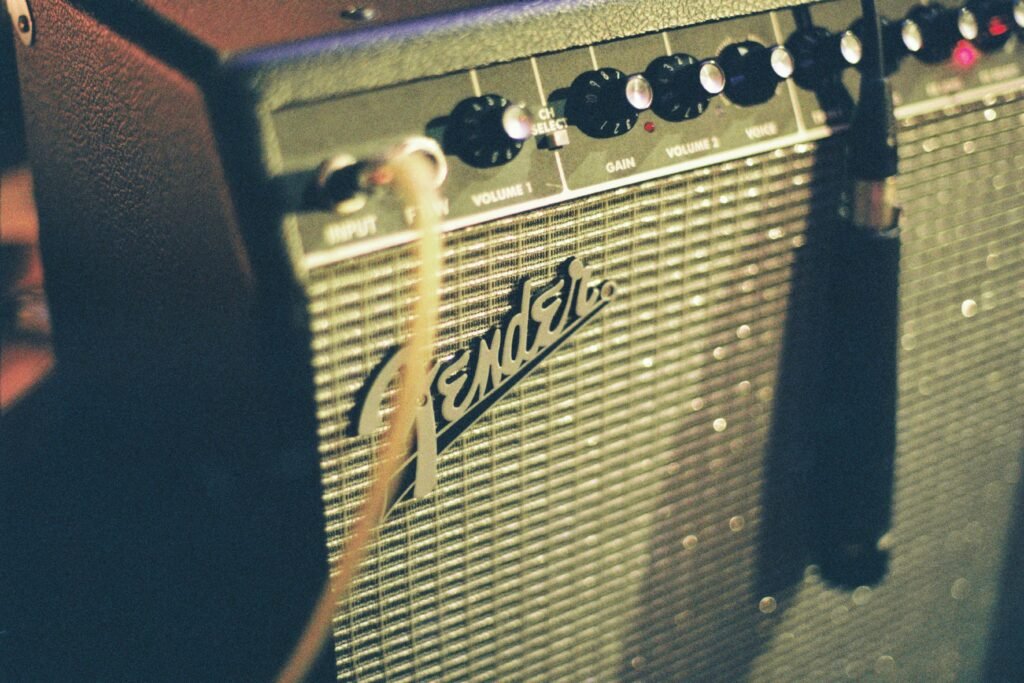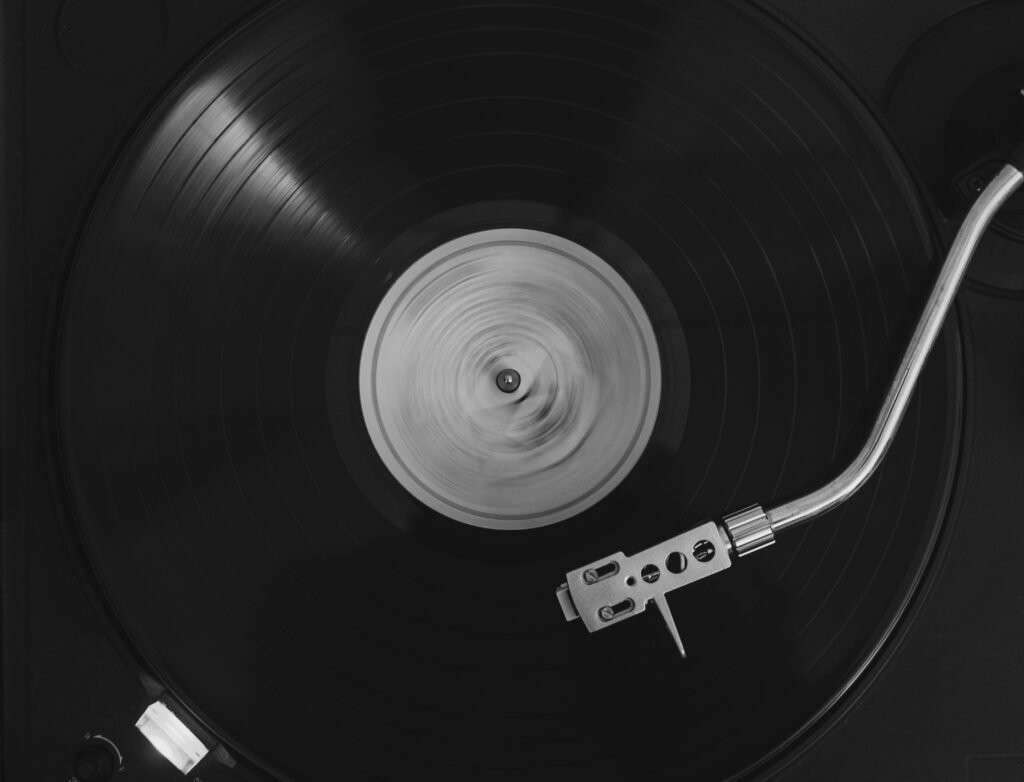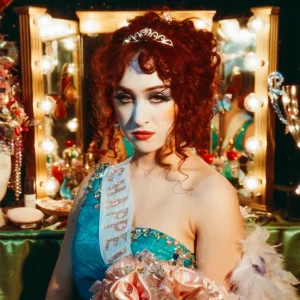Chappell Roan’s The Rise and Fall of a Midwest Princess is a lush, daring, and unapologetically queer pop spectacle that redefines the voice of a heartland outsider. With this debut album, Roan—real name Kayleigh Rose Amstutz—delivers a sonic and visual identity that is bold, self-aware, and distinctly Midwestern. While her previous singles, like “Pink Pony Club” and “Naked in Manhattan,” hinted at her exuberant, genre-bending style, Midwest Princess brings her rebellious persona into full bloom.
The album is a clear departure from the more introspective, subdued sound of her early EP School Nights (2017). Here, Roan dives into a world where small-town naiveté meets big-city dreams, but with a wild twist that celebrates both her roots and her rebellion against them.
Artistic Intentions
The Rise and Fall of a Midwest Princess is a journey of self-liberation and self-acceptance. Roan’s social media and press for the album emphasize her desire to amplify queer voices and claim space for Midwestern identity in mainstream pop. In a sense, the album is both a coming-of-age narrative and an ode to chosen family, queerness, and glamour. She’s not simply looking to sing about love or heartbreak—she’s creating a pop sanctuary for those who don’t often see themselves represented in pop. From her own words, Chappell Roan has aimed to make this album a “glittery, bold statement for every weird kid who felt out of place growing up.”
Sonic Exploration

The Rise and Fall of a Midwest Princess is a triumph of high-gloss pop production interwoven with Chappell Roan’s unique flair for storytelling. Produced with a sleek, crystalline finish, the album’s sound is undeniably polished, but it remains grounded with playful, rebellious grit. Producers like Daniel Nigro, known for his work with Olivia Rodrigo, add a sophisticated touch to the production, making each track feel rich and layered.
Roan and her production team achieve a balance between big, stadium-ready anthems and intimate moments that reveal the raw heart of the album’s themes—identity, freedom, and self-discovery. This pop-forward approach brings out the intensity of her vocals and allows her lyrics to shine, setting the stage for Roan’s heartfelt explorations without losing any of the glitz that her fans have come to love.
Musical Arrangements
Instrumentally, Midwest Princess doesn’t shy away from drama. Tracks like “Pink Pony Club” and “Casual” are standout examples where guitar riffs, shimmering synths, and danceable basslines collide to create a buoyant, full-bodied pop experience. The arrangements are lush and purposeful, with Roan’s voice often layered to provide a choir of harmonies, making the songs feel expansive, as if her voice is filling the world around her. The instrumental mix is consistently playful and textured, with unexpected elements such as brassy horns, disco-inspired beats, and even hints of country twang that nod to her Midwestern roots. These flourishes give each song a sense of place and personality, as if each track is its own little world within Roan’s kingdom of self-expression.
Genre Elements
The album’s genre-blending approach is bold and unabashed, incorporating elements of glam rock, dance-pop, and even traces of 2000s pop-punk energy. Roan’s approach to genre is fluid—at times the music feels like classic pop, while other moments pull from indie, retro synthpop, or even nostalgic 80s influences. This mix of styles not only showcases Roan’s versatility as an artist but also mirrors the album’s theme of identity exploration.
Tracks like “Super Graphic Ultra Modern Girl” exemplify her genre-splicing at its best, moving between punchy pop beats and shimmering synths, with a dash of heartland grit in the lyrics. Roan creates a blend that feels at once familiar and refreshingly original, embracing both her Midwestern roots and a queer, city-slick pop edge.
Lyrical Analysis

In The Rise and Fall of a Midwest Princess, Chappell Roan’s lyrics sparkle with unabashed authenticity, centering around themes of self-discovery, queer liberation, and the paradox of loving and leaving one’s roots. From the outset, Roan transports listeners into her world—a place of both wide-open plains and neon-lit dance floors, where growing up queer in a small town is painted with both nostalgia and rebellion. At its core, this album is a love letter to those who have ever felt out of place but found ways to celebrate their differences. Roan’s lyrics capture this universal desire to be seen and accepted, making the album deeply relatable even as it revels in hyper-specific personal experiences.
Themes
Recurring motifs throughout the album include references to glitter, nightclubs, rural landscapes, and unapologetic self-expression. Tracks like “Pink Pony Club” follow the story of a young woman escaping her conservative upbringing to find freedom in a vibrant queer community. The lyrics in this song are both narrative and poetic, weaving vivid imagery with lines like, “I’m having wicked dreams of leaving Tennessee/ Hear Santa Monica, I swear it’s calling me/ Won’t make my mama proud.”
This lush language conveys both the sense of new belonging and the bittersweet feeling of leaving behind the familiar for the unknown. Roan’s lyrical storytelling shines in its honesty and specificity, painting the journey of her “Midwest Princess” persona as both deeply personal and universally resonant.
The lyrical style across the album is a blend of straightforward narrative and witty, self-aware prose. Roan doesn’t mask her words with heavy abstraction; instead, she lets the rawness of her story shine, often injecting humor and sass into otherwise heavy topics. In “Super Graphic Ultra Modern Girl,” she dives headfirst into themes of gender fluidity and self-presentation, making statements like, “A Super Graphic Ultra Modern Girl like me/ We’re hot We’re drunk.” with playful defiance. These lyrics are impactful not only for their directness but for their celebration of self-acceptance, showcasing Roan’s knack for crafting anthemic choruses that ring out like mantras for the misunderstood.
Emotional Impact
Emotionally, The Rise and Fall of a Midwest Princess is a rollercoaster. The lyrics evoke joy, nostalgia, and moments of melancholy that mirror the album’s theme of transformation. Songs like “Red Wine Supernova” explore love and heartbreak with poignant vulnerability, adding emotional layers that invite listeners to empathize with Roan’s journey. The combination of lyrical depth and conversational tone makes the album feel like an intimate dialogue, where Roan’s reflections on belonging, queerness, and self-love resonate powerfully. Each track contributes to an emotional tapestry that is both celebratory and cathartic, inviting listeners to dance through their pain, triumphs, and everything in between.
Cohesion and Flow

The Rise and Fall of a Midwest Princess is crafted with a remarkable sense of narrative and emotional progression, making it feel as though listeners are experiencing Chappell Roan’s journey in real time. The album opens with tracks that burst with excitement, such as “Pink Pony Club,” where Roan sets the stage for her departure from her rural roots and her embrace of a new, unapologetically queer identity. Each song flows naturally into the next, almost like chapters in a memoir, where one bold statement or revelation leads to another. This seamless track progression keeps the listener engaged, tracing Roan’s emotional highs and lows, from euphoric self-discovery to the bittersweet pangs of leaving behind the past.
There’s a clear narrative arc within the album that mirrors the experience of many who leave home to forge their own paths. Early tracks reflect the initial thrill and freedom of breaking away from convention, while later songs delve into the complexities and challenges that come with living authentically. By the time we reach tracks like “Red Wine Supernova,” the album has moved into a more introspective space, where Roan explores themes of love, loss, and self-reflection, lending a mature and contemplative tone to the latter half of the album. This shift in mood isn’t abrupt but rather a natural progression, as if Roan is peeling back layers of her persona to reveal the vulnerable heart beneath the glitter.
Thematic Consistency
Thematically, the album holds together beautifully, with motifs of self-acceptance, queerness, and rebellion woven consistently throughout. Even as the album moves between upbeat pop anthems and more melancholic ballads, Roan’s voice remains a guiding force, anchoring the project with her unapologetic authenticity. Her commitment to portraying her “Midwest Princess” persona, both defiant and sentimental, helps keep the album’s tone unified. Songs like “Casual” and “Super Graphic Ultra Modern Girl” retain her cheeky confidence, while more intimate tracks like “Kaleidoscope” tap into a sense of longing. These thematic ties give the album a solid foundation, ensuring that even its stylistic shifts feel purposeful rather than jarring.
In terms of musical flow, the album is well-curated, with upbeat, dance-ready tracks strategically placed alongside more reflective numbers. This creates a dynamic listening experience that mirrors the highs and lows of Roan’s own journey without losing the album’s overall momentum. Roan’s skillful balance of tempo and tone ensures that each song feels like a natural extension of the one before, making The Rise and Fall of a Midwest Princess a cohesive body of work that invites listeners to revel in its complexities and contradictions.
Standout Tracks and Moments
Chappell Roan’s The Rise and Fall of a Midwest Princess is filled with moments that sparkle, but a few tracks truly rise to the top, standing out for their emotional intensity, musical daring, and lyrical wit. Here are the highlights that define the album’s spirit and showcase Roan’s immense talent as a pop visionary.
1. “Pink Pony Club”
Often celebrated as Roan’s breakout anthem, “Pink Pony Club” captures the album’s essence—freedom, rebellion, and the joy of self-discovery. This track is an ode to finding a chosen family and identity, with its lyrics telling the story of a small-town girl seeking acceptance in a neon-lit queer club far from home. With a soaring chorus, vibrant synths, and a euphoric beat, it’s impossible not to be swept up in the song’s infectious energy. The track’s bridge, where Roan sings, “It’s where I belong down at the/ Pink Pony Club,” is a moment of pure liberation, inviting listeners to revel in the joy of authenticity. This track sets the tone for the album, positioning Roan as a fearless voice in pop.
2. “Super Graphic Ultra Modern Girl”
In “Super Graphic Ultra Modern Girl,” Roan embraces glam and sass in equal measure, delivering a high-energy, genre-blending pop anthem that defies conventions. The song’s retro-inspired synths and pulsing beats complement its themes of gender fluidity and self-expression, making it a powerful anthem for those rejecting binaries. The lyrics are clever and bold, and Roan’s vocal delivery—equal parts confidence and playfulness—adds a charismatic edge.
3. “Red Wine Supernova”
One of the album’s more introspective tracks, “Red Wine Supernova” stands out for its emotional vulnerability. Here, Roan drops the glittery bravado for a rawer, quieter sound, reflecting on love and loss with a sense of bittersweet acceptance. The minimalistic production lets her voice take center stage, and the lyrics convey a deep yearning that resonates on a universal level. This song also marks a thematic shift in the album, transitioning from the exuberance of earlier tracks to a contemplative introspection. The way Roan draws out certain phrases, stretching them like a sigh, gives the song a haunting beauty and an emotional weight that lingers.
4. “Casual”
“Casual” is a standout for its infectious rhythm and Roan’s clever commentary on modern relationships. With lyrics that playfully explore the push-pull of intimacy and nonchalance, this track takes a familiar theme in contemporary pop and gives it a fresh twist. Roan’s use of humor—“It’s Casual, if it’s casual now/ then baby get me off again”—captures the delicate balance of wanting connection while guarding oneself from hurt. The song’s groove, driven by a catchy bassline and syncopated beats, makes it one of the album’s most danceable tracks while retaining an emotional undercurrent that resonates.
Memorable Moments
The Climactic Bridge in “Pink Pony Club”: This bridge is a defining moment, where Roan’s voice builds in intensity as she proclaims, “Mama, I’m just having fun.” It’s a pivotal lyric that captures her determination to embrace her identity fully, despite the expectations of her past. This moment feels like a triumphant release, encapsulating the album’s core message of self-acceptance.
The Lyrical Playfulness in “Super Graphic Ultra Modern Girl”: The line “I’m a super graphic ultra-modern girl, watch me bend the rules of your world” is a tongue-in-cheek celebration of Roan’s individuality. It’s the kind of lyric that embodies her creative boldness and sense of humor, making it both memorable and anthemic.
Vocal Layering in “Kaleidoscope”: In “Kaleidoscope,” Roan layers her voice to create a mesmerizing, kaleidoscopic effect that mirrors the song’s themes of multiplicity and self-reflection. The vocal production here is subtle yet powerful, capturing the listener in a soundscape that feels like an intimate journey into her psyche.
Emotional Rawness in “Red Wine Supernova”: There’s a moment in this track where Roan’s voice softens and slows, almost cracking under the weight of the lyrics. This vulnerability allows the listener a glimpse into Roan’s deeper emotional landscape, making it one of the most heartfelt moments on the album.
Artistic Contribution and Innovation

With The Rise and Fall of a Midwest Princess, Chappell Roan brings a refreshing and vibrant energy to the pop landscape, pushing boundaries and carving out a space for a new kind of queer, small-town identity in mainstream music. Positioned within the ever-evolving pop genre, the album distinguishes itself by embracing a full-throttle, flamboyant theatricality reminiscent of pop icons like Lady Gaga, while remaining uniquely grounded in Midwestern experiences and identity.
In a time when pop music often trends toward minimalism or hyper-polished commercial appeal, Roan boldly opts for maximalist production and earnest storytelling that feel both nostalgic and refreshingly current. This approach makes her work not only a celebration of personal freedom but a statement of inclusivity and authenticity in pop music.
Genre Blending
Roan’s genre-blending aesthetic, which melds glam rock, synth-pop, and country influences, brings an innovative flair to her music, challenging the idea of what Midwestern pop can be. She moves deftly between the club-ready beats of “Super Graphic Ultra Modern Girl” and the aching vulnerability of “Red Wine Supernova,” creating a sonic diversity that feels representative of her multi-faceted identity. This fluidity is fresh within pop, where even artists pushing boundaries often stay within narrower stylistic lanes. Roan’s embrace of camp, glitter, and vulnerability redefines the genre’s expectations, offering an inclusive vision of pop that prioritizes individuality over mainstream gloss.
Queer Identity
The album’s most groundbreaking element is its unapologetic queerness. Roan doesn’t merely allude to her identity; she centers it, offering a loud and proud depiction of queerness that’s both celebratory and nuanced. While LGBTQ+ themes are gaining visibility in pop, Roan’s perspective—a young queer artist from the Midwest embracing her identity against the backdrop of rural and small-town settings—is rare and refreshing.
Her lyrics touch on themes of belonging, love, and self-discovery that resonate deeply within the queer community, yet her knack for storytelling ensures that the music remains accessible and relatable for all listeners. By bringing her own perspective into the spotlight, Roan amplifies underrepresented voices and helps pave the way for future artists with similarly complex backgrounds.
Production
From a production standpoint, Midwest Princess stands out for its lush layering and dynamic contrasts. Roan and her team of producers and collaborators build vibrant sonic landscapes that evolve throughout each track. The lavish production values—rich synths, punchy drums, and layered vocals—are balanced by Roan’s raw, emotive voice, creating a sound that feels big yet personal.
There’s an element of storytelling not only in her lyrics but also in the way each song unfolds, with subtle tempo changes, instrumental breaks, and dramatic choruses that feel like they’re straight out of a Broadway musical. This approach is relatively rare in pop, where predictable structure often trumps narrative experimentation, and it gives Midwest Princess a cinematic quality that’s both memorable and immersive.
In embracing this bolder, more expressive pop style, Chappell Roan positions herself as an artist capable of pushing the genre’s boundaries and introducing listeners to a dynamic vision of Midwestern queerness. With The Rise and Fall of a Midwest Princess, Roan achieves a synthesis of personal narrative and sonic innovation that sets her apart. The album’s refusal to compromise between glamour and grit, rural roots and big-city dreams, makes it a trailblazer in the pop world, one that invites listeners to join Roan on a journey of self-discovery and celebration—glitter, heartbreak, and all.
Closing Thoughts

The Rise and Fall of a Midwest Princess marks a bold new chapter for Chappell Roan, showcasing her as a dynamic pop artist unafraid to blend heartfelt vulnerability with dazzling, larger-than-life ambition. The album’s strengths lie in its unapologetic authenticity, with Roan embracing both her Midwestern roots and queer identity in ways that feel fresh and empowering. Through infectious melodies, clever lyricism, and genre-blending production, Roan crafts a sound that balances glamour and grit, creating a vivid portrait of someone discovering and celebrating their truest self. Each song is an immersive experience, capturing listeners with catchy hooks while resonating deeply through Roan’s honest storytelling and playful sense of humor.
One of the album’s minor drawbacks, however, is that its maximalist style—while exciting—can occasionally overwhelm its quieter, introspective moments. The larger-than-life production and emotionally charged themes work beautifully on tracks like “Pink Pony Club” and “Super Graphic Ultra Modern Girl,” but in a few instances, the sonic density can slightly distract from Roan’s vocal delivery and lyrical nuances. Yet, this ambitious sound is also part of the album’s charm, as Roan’s willingness to embrace her influences and turn them up to eleven makes her stand out in a pop landscape that often leans toward restraint.
Place in Career
As a debut full-length album, The Rise and Fall of a Midwest Princess sets Chappell Roan up as a new and influential voice in pop, bringing Midwest authenticity and LGBTQ+ pride into the spotlight in a way that feels genuine and needed. For listeners, the album is likely to resonate as a fearless celebration of identity and individuality, while for Roan, it’s a defining milestone that places her in an exciting position to continue exploring her artistic vision and challenging genre conventions.
Official Rating
This album earns a solid 8 out of 10 for its daring approach, emotional depth, and infectious energy. Chappell Roan has crafted a pop debut that is both sonically ambitious and deeply personal, offering something unique and necessary to today’s music scene. The album’s few moments of excess don’t detract from its overall impact; instead, they underscore her ambition and creativity, suggesting even more potential for growth and innovation in her future work.
